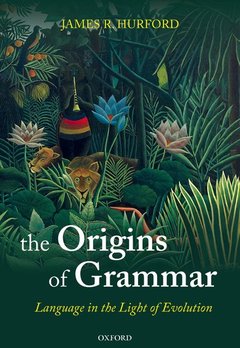The Origins of Grammar Language in the Light of Evolution II Oxford Studies in the Evolution of Language Series
Langue : Anglais
Auteur : Hurford James R.

This is the second of the two closely linked but self-contained volumes that comprise James Hurford's acclaimed exploration of the biological evolution of language. In the first book he looked at the evolutionary origins of meaning, ending as our distant ancestors were about to step over the brink to modern language. He now considers how that step might have been taken and the consequences it undoubtedly had. The capacity for language lets human beings formulate and express an unlimited range of propositions about real or fictitious worlds. It allows them to communicate these propositions, often overlaid with layers of nuance and irony, to other humans who can then interpret and respond to them. These processes take place at breakneck speed. Using a language means learning a vast number of arbitrary connections between forms and meanings and rules on how to manipulate them, both of which a normal human child can do in its first few years of life. James Hurford looks at how this miracle came about. The book is divided into three parts. In the first the author surveys the syntactic structures evident in the communicative behaviour of animals, such as birds and whales, and discusses how vocabularies of learned symbols could have evolved and the effects this had on human thought. In the second he considers how far the evolution of grammar depended on biological or cultural factors. In the third and final part he describes the probable route by which the human language faculty and languages evolved from simple beginnings to their present complex state.
Part I: Pre-Grammar. Introduction to Part I: Twin Evolutionary patterns - Animal Song and Human Symbols. 1. Animal Syntax? Implications for Language as Behaviour. 2. First Shared Lexicon. Part II: What Evolved. Introduction to Part II: Some Linguistics - How to Study Syntax and What Evolved. 3. Syntax in the Light of Evolution. 4. What Evolved: Language Learning Capacity. 5. What Evolved: Languages. Part III: What Happened. Introduction to Part III: What Happened - The Evolution of Syntax. 6. The Pre-existing Platform. 7. Gene-Language Coevolution. 8. One Word, Two Words. 9. Grammaticalization. Sendoff. References. Index.
James R. Hurford is Emeritus Professor of General Linguistics, University of Edinburgh. He is co-editor, with Kathleen Gibson, of OUP's Studies in Language Evolution, co-founder, with Simon Kirby, of the Language Evolution and Computation Research Unit at the University of Edinburgh, and co-founder, with Chris Knight, of the EVOLANG series of international conferences on the evolution of language. His books include The Linguistic Theory of Numerals (CUP, 1975), Language and Number: The Emergence of a Cognitive System (Blackwell, 1987), Grammar: A Student's Guide (CUP 1994), and The Origins of Meaning (OUP 2007).
Date de parution : 09-2011
Ouvrage de 808 p.
18.1x25 cm
Thèmes de The Origins of Grammar :
© 2024 LAVOISIER S.A.S.



